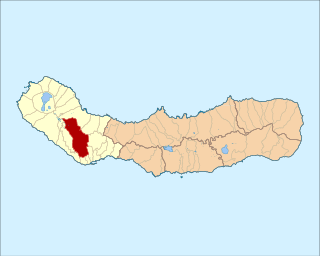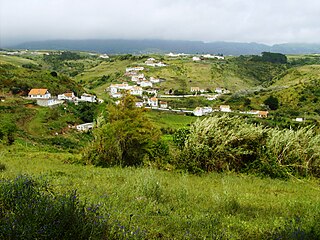
Vila do Porto is the single municipality, the name of the main town and one of the civil parishes on the island of Santa Maria, in the Portuguese archipelago of Azores. Its nearest neighbor, administratively, is the municipality of Povoação on the southern coast of São Miguel, and it is physically southwest of the islets of the Formigas. The population in 2021 was 5,408, in an area of 96.89 km2 (37.41 sq mi).

Angra do Heroísmo, or simply Angra, is a city and municipality on Terceira Island, Portugal, and one of the three capital cities of the Azores. Founded in 1478, Angra was historically the most important city in the Azores, as seat of the Bishop of the Azores, government entities, and having previously served as the capital city of Portugal during the Liberal Wars. The population in 2011 was 35,402, in an area of 239.00 km2. It was classified as a World Heritage site by UNESCO in 1983.

Santa Cruz das Flores is a municipality situated in the north half of the island of Flores, in the Portuguese archipelago of the Azores. Situated in the sparsely populated Western Group, the population in 2021 was 2,020 inhabitants in an area that covers approximately 70.91 square kilometres (27.38 sq mi), bordering the southern municipality of Lajes das Flores.

Conceição is a freguesia in the municipality of Horta in the Portuguese Azores. The population in 2011 was 1,138, in an area of 3.08 km². It is the second smallest parish within the administration of Horta.

Ajuda da Bretanha is a northern civil parish in the municipality of Ponta Delgada, on the island of São Miguel in the Portuguese archipelago of the Azores. It is a relatively new parish, being elevated to this status when the former parish of Bretanha was divided, forming Ajuda and Pilar da Bretanha. The population in 2011 was 661, in an area of 7.09 km2. It contains the localities Ajuda da Bretanha, Amoreira and Lombinha.

Arrifes is a civil parish in the municipality of Ponta Delgada on the island of São Miguel in the Azores. The population in 2011 was 7,086, in an area of 25.37 km².
Covoada is a civil parish in the municipality of Ponta Delgada, on the island of São Miguel in the Azores. The population in 2011 was 1,341, in an area of 9.03 km2. It contains the localities Covoada, Nossa Senhora da Graça and Pavões.

Fajã de Cima is a civil parish in the municipality of Ponta Delgada in the Portuguese archipelago of the Azores. Fajã de Cima is located in the Picos region in the western part of the island of São Miguel, north of central Ponta Delgada. The population in 2011 was 3,438, in an area of 11.89 km².

Feteiras is a civil parish in the municipality of Ponta Delgada in the Portuguese archipelago of the Azores. It is situated in the western part of the island of São Miguel, on the south coast. The population in 2011 was 1,571, in an area of 23.53 square kilometres (9.08 sq mi).

Livramento is a civil parish in the municipality of Ponta Delgada in the Portuguese archipelago of the Azores. The population in 2011 was 4,062, in an area of 5.59 square kilometres (2.16 sq mi).

Pilar da Bretanha is a civil parish in the municipality of Ponta Delgada on the island of São Miguel, in the Portuguese archipelago of the Azores. It was de-annexed from the historical parish of Bretanha on 10 July 2002, along with Ajuda da Bretanha. The population in 2011 was 624, in an area of 6.07 square kilometres (2.34 sq mi). It contains the localities Casa Telhada, Covas, João Bom and Pilar.

Ribeira Grande is a municipality in the northern part of the island of São Miguel in the Portuguese Azores. The population in 2011 was 32,112, in an area of 180.15 km2. The municipal seat is located in the civil parish of Matriz, with a population of about 4000 inhabitants, part of the urbanized core of what is commonly referred to as the city of Ribeira Grande.

Fenais da Ajuda is a civil parish in the municipality of Ribeira Grande in the Portuguese archipelago of the Azores. The population in 2011 was 1,131, in an area of 13.36 km2.

Povoação is a municipality located in the southeastern corner of the island of São Miguel in the Portuguese archipelago of the Azores. The population in 2011 was 6,327, in an area of 106.41 km2.

Furnas is a civil parish in the municipality of Povoação on the island of São Miguel in the Portuguese Azores. The population in 2011 was 1,439, in an area of 34.43 km2. The parish is one of the largest in the island and in the Azores. It is located east of Lagoa and Ponta Delgada, west of Povoação and southeast of Ribeira Grande.

Achada is a freguesia in the municipality Nordeste on the island of São Miguel in the Azores. The population in 2011 was 436, in an area of 11.89 km2.

Vila do Porto is a civil parish in the municipality of Vila do Porto, located on the island of Santa Maria, in the Portuguese autonomous region of Azores. It is the southernmost and easternmost parish in the archipelago of Azores. The population in 2011 was 3,119, in an area of 25.55 km².

The Convent of Caloura is a Portuguese 16th-century convent located in the civil parish of Água de Pau, in the municipality of Lagoa, on the island of São Miguel in the archipelago of the Azores.

The Church of Santa Cruz is a Catholic church situated in the civil parish of Santa Cruz, in the municipality of Lagoa, in the Portuguese archipelago of the Azores.





















